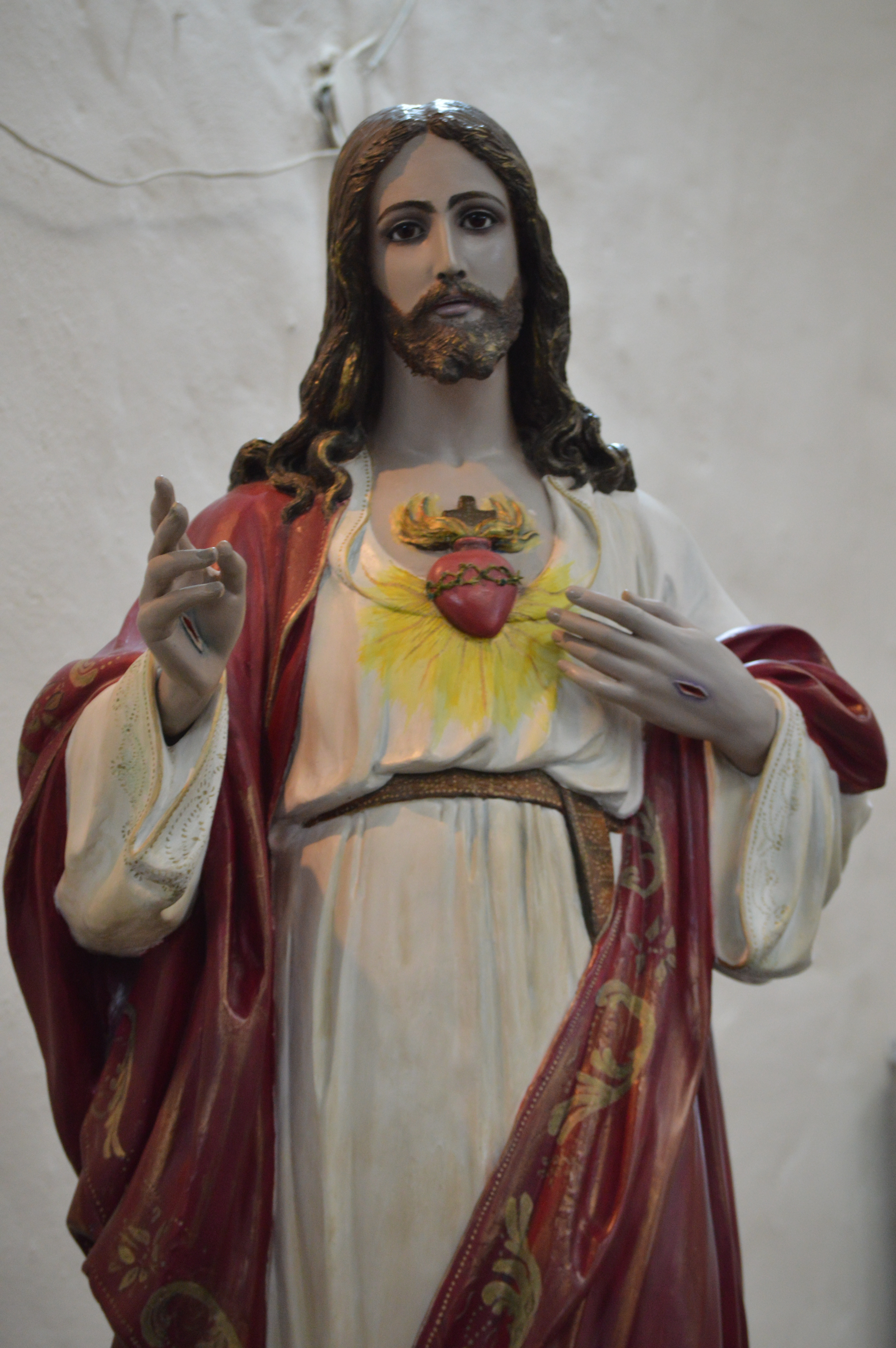We might think Jesus had nothing to cry about. After all, he knows that the life we experience after earthly death is the point at which our eyes are opened and our hearts are completely filled at last. He knows that he will soon raise Lazarus from the dead, and everyone will be rejoicing and their sorrow forgotten. So, why did he weep?
It seems he wept at the sight of others’ sorrow; he saw Mary and the others grieving over Lazarus’ death and became “perturbed and deeply troubled,” and he wept. This is a profound insight into the very Heart of the Savior – a compassionate heart truly entering into the sorrow of others and reaching out to alleviate their pain.
He is again “perturbed” when some of the bystanders suggest that he was unable to do anything about this, that he should have done something earlier to save Lazarus. What caused this agitation was not that he took personal offense at their doubtfulness. His Heart is always for others first! His pain was caused by their continued lack of faith, which was detrimental to THEM, not to him. He is the Savior and Redeemer, who calls them to believe and trust.
Jesus is also a Teacher, who does not miss any “teachable moment.” So, as he is about to perform this extraordinary act, he wants to make sure that the lessons are understood clearly. One of these lessons is that Jesus only does what the Father wills, that his power over sickness and demons and death itself is the will of the Father and comes from the Father (“Father, I thank you for hearing me. I know that you always hear me.”) but it is truly also HIS power. In the Gospel, Jesus never asks the Father to do the healing, the casting out, or the raising from the dead; he speaks directly for himself. “He cried out in a loud voice, ‘Lazarus, come out!’ The dead man came out.”
In this one scene, Jesus is accomplishing many things, “for the glory of God, that the Son of God may be glorified through it”:
- Jesus shows he is beyond any fear of perceived danger by returning to the people who had rejected him and tried to stone him to death.
- Jesus reminds the disciples that he walks by a greater light, and they can too.
- Jesus strengthens the faith of those present and declares, “I am the resurrection and the life.”
- Jesus raises the one he loves, four days after he died.
- Jesus restores a brother to two grieving sisters.
- Jesus demonstrates his divine power to the bystanders and the disciples.
- Jesus draws many others to believe in him.
This Lent, has my faith deepened? Do I believe that whatever God allows is for a greater good, for His greater glory? Do I trust that his love and mercy never fail and will ultimately relieve every sorrow? Is my heart freer to receive the fullness of redemption in Christ?
Podríamos pensar que Jesús no tenía nada por qué llorar. Después de todo, él sabe que la vida que experimentamos después de la muerte terrenal es el punto en el que nuestros ojos se abren y nuestros corazones se llenan por fin. Sabe que pronto resucitará a Lázaro de entre los muertos, y todos se regocijarán y olvidarán su dolor. Entonces, ¿por qué lloró?
Parece que lloró al ver el dolor de los demás; vio a María y a los demás afligidos por la muerte de Lázaro y se “se conmovió hasta lo más hondo”, y lloró. Esta es una visión profunda del Corazón mismo del Salvador: un corazón compasivo que realmente se adentra en el dolor de los demás y se extiende para aliviar su dolor.
Él está nuevamente “conmovido” cuando algunos de los espectadores sugieren que no pudo hacer nada al respecto, que debería haber hecho algo antes para salvar a Lázaro. Lo que causó esta agitación no fue que se sintiera ofendido personalmente por sus dudas. ¡Su Corazón siempre está para los demás primero! Su dolor fue causado por su continua falta de fe, lo cual fue perjudicial para ELLOS, no para él. Él es el Salvador y Redentor, que los llama a creer y confiar.
Jesús es también un Maestro, que no se pierde ningún “momento de enseñanza”. Entonces, cuando está a punto de realizar este acto extraordinario, quiere asegurarse de que las lecciones se entiendan claramente. Una de estas lecciones es que Jesús solo hace lo que el Padre quiere, que su poder sobre la enfermedad y los demonios y la muerte misma es la voluntad del Padre y viene del Padre (“Padre, te doy gracias porque me has escuchado. Yo ya sabía que tú siempre me escuchas.”) pero verdaderamente también es SU poder. En el Evangelio, Jesús nunca le pide al Padre que haga la curación, la expulsión o la resurrección de los muertos; habla directamente por sí mismo. “Luego gritó con voz potente: ‘¡Lázaro, sal de allí!’ Y salió el muerto”.
En esta escena, Jesús está logrando muchas cosas, “para la gloria de Dios, para que el Hijo de Dios sea glorificado por medio de ella”:
- Jesús muestra que está más allá de cualquier temor de peligro al regresar donde la gente que lo había rechazado y tratado de apedrearlo hasta la muerte.
- Jesús les recuerda a los discípulos que él camina en una luz mayor, y ellos también pueden hacerlo.
- Jesús fortalece la fe de los presentes y declara: “Yo soy la resurrección y la vida”.
- Jesús resucita al que ama, cuatro días después de su muerte.
- Jesús restaura un hermano a dos hermanas afligidas.
- Jesús demuestra su poder divino a los espectadores y a los discípulos.
- Jesús atrae a muchos otros a creer en él.
Esta Cuaresma, ¿se ha profundizado mi fe? ¿Creo que todo lo que Dios permite es para un bien mayor, para su mayor gloria? ¿Confío en que su amor y misericordia nunca fallan y finalmente aliviará cada dolor? ¿Está mi corazón más libre para recibir la plenitud de la redención en Cristo?
 Kathryn Mulderink, MA, is married to Robert, Station Manager for Holy Family Radio. Together they have seven children (including Father Rob), and seven grandchildren. She is President of the local community of Secular Discalced Carmelites and has published five books and many articles. Over the last 30 years, she has worked as a teacher, headmistress, catechist, Pastoral Associate, and DRE, and as a writer and voice talent for Catholic Radio. Currently, she serves the Church by writing and speaking, and by collaborating with various parishes and to lead others to encounter Christ and engage their faith. Her website is www.KathrynTherese.com
Kathryn Mulderink, MA, is married to Robert, Station Manager for Holy Family Radio. Together they have seven children (including Father Rob), and seven grandchildren. She is President of the local community of Secular Discalced Carmelites and has published five books and many articles. Over the last 30 years, she has worked as a teacher, headmistress, catechist, Pastoral Associate, and DRE, and as a writer and voice talent for Catholic Radio. Currently, she serves the Church by writing and speaking, and by collaborating with various parishes and to lead others to encounter Christ and engage their faith. Her website is www.KathrynTherese.com
Feature Image Credit: Rita Laura, https://cathopic.com/photo/11441-ternura-y-amor

